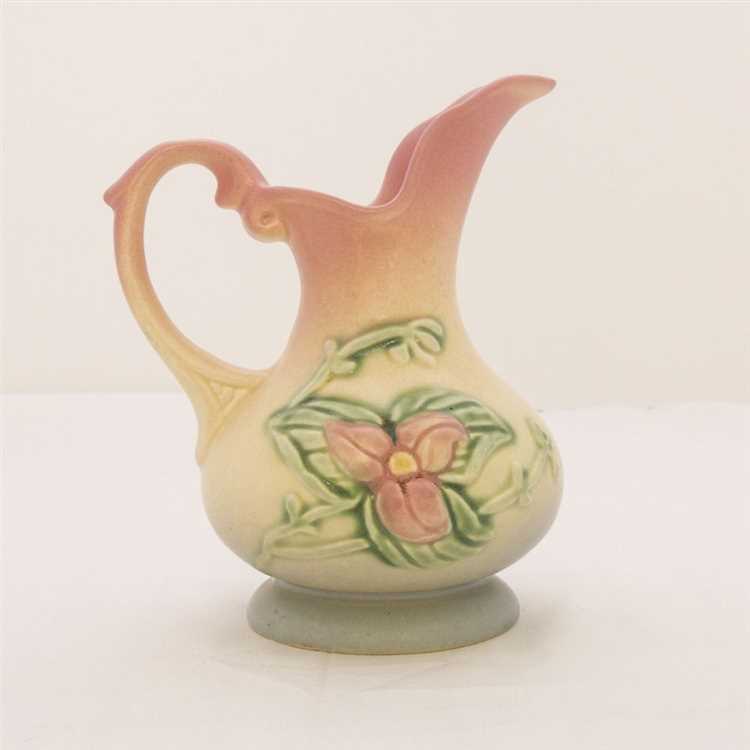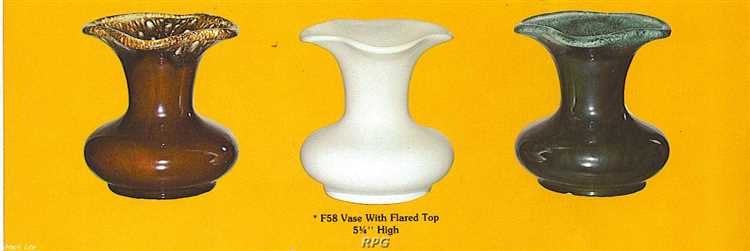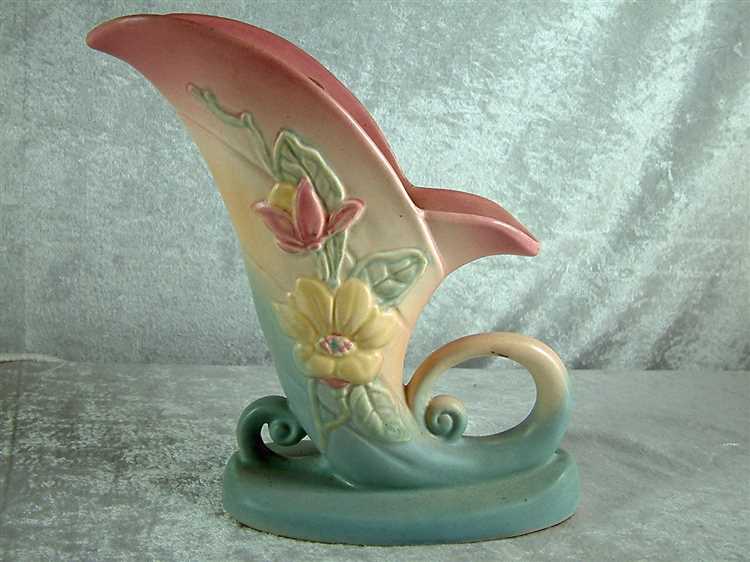When it comes to collecting pottery, one name that often comes up is Hull Pottery. Founded in 1905 in Crooksville, Ohio, Hull Pottery quickly gained recognition for its high-quality ceramic artware. Over the years, Hull Pottery pieces have become highly sought after by collectors worldwide.
But how valuable is Hull Pottery really? Determining the worth of a piece of pottery involves several factors, including condition, rarity, and demand. Hull Pottery has a wide range of designs and styles, from colorful floral patterns to whimsical animal figurines, which can influence its value.
In general, Hull Pottery pieces in excellent condition and with rare designs tend to command higher prices. Collectors also look for pieces that were produced in limited quantities, as they are often considered more valuable. Additionally, the demand for Hull Pottery has remained strong among enthusiasts, which has further contributed to its value.
However, it’s important to note that not all Hull Pottery pieces are valuable. Like any collectible, their worth can vary greatly depending on several factors. Some pieces may only hold sentimental value for their owners, while others may be worth thousands of dollars to avid collectors.
Overall, the true worth of Hull Pottery pieces is subjective and can differ from person to person. If you’re interested in collecting Hull Pottery, it’s recommended to do thorough research and consult with experts to determine the value of specific pieces. Whether you’re a seasoned collector or just starting out, the beauty and craftsmanship of Hull Pottery pieces are undeniable, making them a valuable addition to any pottery collection.
Exploring the History of Hull Pottery
Hull Pottery was founded in 1905 in Crooksville, Ohio by Addis Emmet Hull. The company originally began as the A.E. Hull Pottery Company, producing simple utilitarian pottery such as stoneware and flower pots.
In the 1920s, Hull Pottery shifted its focus to decorative art pottery, influenced by popular ceramic styles of the time, including Art Deco and Arts and Crafts. This change in direction allowed the company to expand its market and gain recognition for its innovative designs.
Hull Pottery became well-known for its distinctive glazes and intricate hand-painted designs. The company’s artists developed several iconic patterns, including the popular “Little Red Riding Hood” pattern, which featured a young girl in a red cape.
During the 1930s and 1940s, Hull Pottery experienced tremendous success and growth. The company introduced new lines of pottery, including vases, bowls, and figurines, which became highly sought after by collectors. Hull Pottery also expanded its production facilities to meet the increasing demand for its products.
In the 1950s, Hull Pottery continued to flourish, introducing its famous “Gloss Moderne” line, characterized by its sleek modern designs and glossy glazes. This line proved to be incredibly popular and cemented Hull Pottery’s reputation as a leader in the ceramic industry.
Unfortunately, the success of Hull Pottery was short-lived. In the 1960s, increased competition from foreign manufacturers and changing consumer tastes led to a decline in sales for the company. In 1986, Hull Pottery ceased production, marking the end of an era for this iconic American pottery manufacturer.
Despite its closure, Hull Pottery remains highly collectible today. The company’s unique and beautifully crafted pieces continue to be admired and valued by collectors all over the world. Whether it’s a vintage vase or a whimsical figurine, Hull Pottery pieces are cherished for their artistic merit and historical significance.
If you’re interested in starting a collection of Hull Pottery, it’s important to familiarize yourself with the different patterns and styles produced by the company. With so many variations and designs, it’s crucial to do your research and consult with experts or reference materials to ensure you’re purchasing genuine Hull Pottery pieces.
Factors that Influence the Value of Hull Pottery
Hull Pottery is highly sought after by collectors for its craftsmanship and unique designs. While there is no definitive formula for determining the value of Hull Pottery pieces, several factors can influence their worth. These factors include:
- Age: Generally, older Hull Pottery pieces tend to be more valuable than newer ones. This is because older pieces are often rarer and have a greater historical significance.
- Condition: The condition of a Hull Pottery piece plays a crucial role in determining its value. Pieces with minimal or no damage, such as cracks, chips, or repairs, are typically more valuable than those with visible flaws.
- Rarity: The rarity of a Hull Pottery piece can significantly impact its value. Limited production runs, discontinued lines, or unique designs can make a piece more desirable and, consequently, more valuable.
- Pattern and Design: Certain patterns and designs are more popular among collectors. Pieces featuring intricate artwork, vibrant colors, or distinctive shapes are generally more valuable than those with simpler designs.
- Popularity: The popularity of a specific line or style of Hull Pottery can affect its value. Pieces that are highly sought after by collectors or have a dedicated fan base may command higher prices.
- Market Demand: Market demand and trends can also influence the value of Hull Pottery. If there is a surge in interest or a high demand for a particular piece or style, its value may increase accordingly.
- Provenance: The provenance or documented history of a Hull Pottery piece can add value. Pieces with a notable ownership history or those associated with famous individuals or events may have a higher worth.
It is important to note that these factors are not exhaustive and can vary depending on the specific piece and the market. Consulting with experts or referencing reputable price guides can be helpful in determining the value of a particular Hull Pottery piece.
Identifying Authentic Hull Pottery Pieces
When collecting Hull pottery, it’s important to be able to identify authentic pieces to ensure their true value. Here are some tips to help you determine whether a piece of Hull pottery is genuine:
- Check for the Hull Pottery mark: Authentic Hull pottery pieces will typically have a mark on the bottom indicating the manufacturer. Look for the words “Hull,” “Hull Pottery,” or “Hull USA” along with a model or style number.
- Examine the glaze: Hull pottery is known for its distinct glazes, which often have a glossy, almost pearl-like appearance. Look for a smooth and even glaze that has not chipped or cracked.
- Inspect the shape and design: Hull pottery pieces were produced in a wide range of styles and shapes. Familiarize yourself with the different designs and patterns used by Hull Pottery, such as the popular “Woodland” or “Wildflower” patterns. Be wary of any pieces that deviate significantly from these known designs.
- Look for quality craftsmanship: Genuine Hull pottery is typically well-crafted with attention to detail. Look for clean, crisp lines and smooth edges. Avoid pieces with uneven or sloppy craftsmanship, as they may be reproductions or imitations.
- Research the piece: Before making a purchase, research the specific piece of Hull pottery you are interested in. Look for additional information, such as year of production, rarity, and any special markings or identifying features. This will help you verify its authenticity and determine its value.
Remember that while these tips can help you identify genuine Hull pottery pieces, it’s always a good idea to consult with experts or experienced collectors for further guidance. Building knowledge and expertise in the field will greatly enhance your ability to spot authentic pieces and ensure you are making a valuable addition to your collection.
Common Types of Hull Pottery
Hull Pottery is known for its wide range of styles and designs. Collectors and enthusiasts can find various types of Hull Pottery pieces that range from simple and functional to intricate and decorative. Below are some of the common types of Hull Pottery:
- Lusterware: Hull Pottery produced lusterware pieces that were popular in the early 20th century. These pieces have a shiny metallic glaze, often in vibrant colors. Lusterware pieces from Hull Pottery are highly sought after by collectors.
- Brown Drip: The Brown Drip line is one of the most recognizable and popular lines of Hull Pottery. It features a dark brown glaze with drips of lighter brown or tan. Brown Drip pieces were produced in various shapes and sizes, including dishes, mugs, and vases.
- Mirror Brown: Mirror Brown pottery from Hull has a distinctive glossy brown glaze. These pieces are often simple in design and can range from vases to planters. Mirror Brown pottery is highly collectible.
- Wildflower: The Wildflower line of Hull Pottery features a hand-painted floral design. Pieces from this line often have a cream-colored background with colorful flowers and foliage. The Wildflower line includes vases, bowls, and pitchers.
- Woodland: Woodland pottery from Hull is known for its woodland-themed motifs, such as trees, leaves, and animals. The designs are usually raised, giving the pieces a three-dimensional look. Woodland pottery can be found in various colors, including green, brown, and yellow.
These are just a few examples of the many types of Hull Pottery that collectors and enthusiasts can find. Each line of Hull Pottery has its own unique characteristics and appeal, making it a fascinating area of interest for many pottery collectors.
How to Determine the Value of Hull Pottery
Determining the value of Hull Pottery can involve a combination of factors, including the specific piece, its condition, the rarity of the design, and the current market demand. Here are some steps to help you determine the value of your Hull Pottery:
- Research: Start by researching the specific piece of Hull Pottery you have. Look for similar pieces sold at auctions, antique stores, and online marketplaces. This will give you an idea of the price range for your piece.
- Condition: Evaluate the condition of your Hull Pottery. Pieces in excellent condition without any chips, cracks, or repairs are generally more valuable. Minor flaws may decrease the value.
- Markings and Backstamps: Check the underside of your Hull Pottery piece for any markings or backstamps. Some pieces may have unique markings that indicate their rarity or production era. Research these markings to determine their significance.
- Rarity and Demand: Consider the rarity and desirability of your Hull Pottery piece. Some designs or patterns may be more sought after by collectors, increasing their value. Look for specific details, such as limited editions or discontinued lines, that can increase the rarity.
- Get Appraisals: If you’re unsure about the value of your Hull Pottery, consider getting professional appraisals. Appraisers specialize in evaluating the worth of antiques and collectibles and can provide you with a more accurate assessment.
- Selling Platforms: Determine the best selling platform for your Hull Pottery. Options include online marketplaces like eBay or Etsy, antique stores, or specialized pottery auctions. Consider the fees associated with each platform and the potential audience for your piece.
- Monitor the Market: Keep an eye on the market for Hull Pottery. Prices can fluctuate over time, so staying informed about current trends and demand will help you determine the best time to sell your piece.
Remember that the value of Hull Pottery can vary depending on individual factors, and prices are subject to change. It’s always a good idea to consult with experts or experienced collectors to ensure you’re making an informed decision when buying or selling Hull Pottery.
Tips for Caring for Your Hull Pottery Collection
Whether you have inherited a collection of Hull Pottery or have recently started collecting it, taking proper care of your pieces is essential to preserve their value and beauty. Here are some tips to help you maintain your Hull Pottery collection:
- Handle with care: Hull Pottery is delicate, so always handle your pieces with care. Avoid dropping or banging them against hard surfaces, as this can lead to chips, cracks, or breaks.
- Clean gently: When cleaning your Hull Pottery, use mild dish soap and warm water. Avoid using abrasive cleaners or scrubbing brushes, as they can scratch the glaze. Use a soft cloth or sponge to gently clean the surface.
- Avoid extreme temperatures: Hull Pottery should be kept away from extreme temperature changes. Sudden temperature fluctuations can cause the pottery to crack or break. Avoid placing your pieces in direct sunlight or near heat sources.
- Store properly: Proper storage is crucial for preserving the condition of your Hull Pottery. When not on display, wrap each piece in acid-free tissue paper or bubble wrap to protect it from dust and scratches. Store them in a sturdy box or container, away from moisture and humidity.
- Display with caution: If you choose to display your Hull Pottery collection, make sure to use stable and secure shelves or display cabinets. Avoid overcrowding the display area, as this can increase the risk of accidental damage.
- Inspect regularly: Regularly inspect your Hull Pottery pieces for any signs of damage or deterioration. Look for chips, cracks, or discoloration. Promptly address any issues by consulting a professional restoration expert, if necessary.
- Document your collection: Keeping a detailed record of your Hull Pottery collection can be helpful for insurance purposes or future appraisals. Take photographs of each piece, note any distinguishing marks or signatures, and keep the documentation in a safe place.
- Handle with gloves: To prevent oils, dirt, or residue from your hands transferring onto the pottery, it is recommended to wear gloves when handling your Hull Pottery collection. This will help maintain its pristine condition and avoid unnecessary cleaning.
- Avoid using for food or beverages: While Hull Pottery was originally designed for everyday use, it is best to avoid using it for food or beverages. Over time, the glaze can wear off, and the pottery can become more susceptible to damage.
By following these tips, you can ensure that your Hull Pottery collection remains in excellent condition and retains its value for years to come. Remember to always handle, clean, and store your pieces with care.
Where to Buy and Sell Hull Pottery
Whether you’re a collector looking to add to your Hull Pottery collection or someone looking to sell your Hull Pottery pieces, there are several options available to you.
1. Antique Shops and Vintage Stores: Antique shops and vintage stores often carry a variety of Hull Pottery pieces. These establishments specialize in selling collectibles and antiques, making them a great place to find and buy Hull Pottery. Keep in mind that prices may vary, so it’s a good idea to do some research on the current market value of the pieces you’re interested in before making a purchase.
2. Online Marketplaces: Online marketplaces, such as eBay, Etsy, and Ruby Lane, provide a wide range of options for buying and selling Hull Pottery. These platforms allow collectors and sellers from around the world to connect and make transactions. When buying or selling on these platforms, it’s important to carefully read descriptions, look at photos, and check the seller’s reputation and feedback to ensure a smooth and trustworthy transaction.
3. Collectible Shows and Antique Fairs: Collectible shows and antique fairs often have vendors who specialize in selling Hull Pottery. These events can provide a unique opportunity to see a wide variety of pieces in person and connect with knowledgeable sellers. Keep in mind that admission fees and travel expenses may apply when attending these events.
4. Online Forums and Communities: Online forums and communities dedicated to pottery collecting can be a valuable resource for buying and selling Hull Pottery. These platforms allow collectors to connect, share information, and buy or sell pieces directly from other enthusiasts. Participating in these communities can provide access to a wide network of like-minded individuals who can help you find or sell Hull Pottery.
5. Estate Sales and Auctions: Estate sales and auctions can be a fruitful hunting ground for finding Hull Pottery pieces at potentially lower prices. Keep an eye out for local estate sales or auctions that advertise pottery collections. It’s important to carefully inspect items before purchasing, as these events often sell pieces in as-is condition.
Remember, when buying or selling Hull Pottery, it’s crucial to familiarize yourself with the various marks, patterns, and characteristics of genuine pieces. Doing so will help you determine authenticity and ensure that you’re getting the best value for your money.
FAQ:
Is Hull Pottery considered valuable?
Yes, Hull Pottery is considered valuable among collectors and enthusiasts.
What factors determine the value of Hull Pottery?
The value of Hull Pottery is determined by factors such as rarity, age, condition, design, and demand among collectors.
Are all Hull Pottery pieces valuable?
Not all Hull Pottery pieces are valuable. Some may be more common or less sought after by collectors, which can affect their value.
How can I determine the value of my Hull Pottery piece?
To determine the value of your Hull Pottery piece, you can consult price guides, check online auction sites or specialized pottery websites, or seek the advice of a knowledgeable appraiser.
What are some rare pieces of Hull Pottery that are highly valuable?
Some rare and highly valuable pieces of Hull Pottery include the Hull Woodland line, the Hull Ebb Tide line, and certain one-of-a-kind or limited edition pieces.
Can Hull Pottery appreciate in value over time?
Yes, Hull Pottery has the potential to appreciate in value over time. If a particular line or piece becomes more sought after by collectors, its value can increase.
What should I consider if I want to start collecting Hull Pottery?
If you want to start collecting Hull Pottery, you should consider factors such as your budget, your personal taste in designs, the availability of pieces in your area, and the knowledge and resources you have for researching and caring for your collection.


